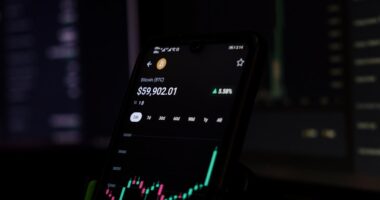Non-fungible tokens (NFTs) are digital assets that represent ownership or authenticity of unique items or content, such as artwork, videos, music, or collectibles, using blockchain technology. Unlike fungible cryptocurrencies like Bitcoin or Ethereum, which can be exchanged on a one-to-one basis, NFTs are unique and cannot be exchanged like-for-like. This uniqueness and scarcity contribute to their value and appeal among collectors and investors.
In recent years, NFTs have gained significant attention for their potential to transform the buying, selling, and ownership of digital content. They have created new opportunities for artists, creators, and collectors to monetize and trade digital assets securely and transparently. NFTs have also become a cultural phenomenon, with high-profile sales of digital art and collectibles reaching millions of dollars and capturing public interest.
As the NFT market continues to expand and develop, understanding the technology and functionality of NFTs is increasingly important.
Key Takeaways
- NFTs are unique digital assets that represent ownership or proof of authenticity of a specific item or piece of content.
- NFTs work by using blockchain technology to create a digital certificate of ownership that cannot be duplicated or forged.
- The technology behind NFTs is based on blockchain, a decentralized and secure digital ledger that records transactions across multiple computers.
- NFTs have had a significant impact on the art world, allowing artists to sell their work directly to collectors and receive royalties for future sales.
- Risks and challenges associated with NFTs include high energy consumption, copyright infringement, and the potential for market manipulation.
How do NFTs work?
Unique Identifiers and Metadata
When an NFT is created, it is assigned a unique identifier that distinguishes it from all other tokens on the blockchain. This identifier is what gives the NFT its non-fungible properties, as it cannot be replicated or exchanged for an identical token. The creator of the NFT can also embed metadata into the token, such as the title, description, and digital file of the associated artwork or content.
Buying and Selling NFTs
Once created, NFTs can be bought and sold on various online marketplaces and platforms that support blockchain transactions. When a transaction occurs, the ownership of the NFT is transferred from the seller to the buyer, with the details of the transfer recorded on the blockchain. This process ensures that the provenance and ownership of the NFT are verifiable and cannot be disputed.
Benefits of NFTs
The buyer then has full control over their NFT, including the ability to display, resell, or transfer it to another party. This flexibility and security make NFTs an attractive option for artists, collectors, and investors looking to engage in the digital art and collectibles market.
The technology behind NFTs

NFTs are built on blockchain technology, which is a decentralized and distributed ledger that records transactions across a network of computers. Blockchain technology provides a secure and transparent way to track the ownership and provenance of digital assets, making it an ideal platform for creating and trading NFTs. The use of blockchain ensures that each NFT has a unique identifier and a verifiable history of ownership, preventing fraud and counterfeit copies.
Smart contracts are another key technology that underpins NFTs. Smart contracts are self-executing contracts with the terms of the agreement between buyer and seller directly written into code. When an NFT is created or transferred, a smart contract is used to automate the process and ensure that the transaction is executed according to the agreed-upon terms.
This eliminates the need for intermediaries or third parties, reducing transaction costs and increasing efficiency. The use of metadata is also important in the technology behind NFTs. Metadata allows creators to embed additional information about their NFTs, such as the title, description, and digital file of the associated artwork or content.
This metadata enhances the value and authenticity of the NFT, providing collectors and investors with more context and background about the digital asset they are purchasing. Overall, the combination of blockchain technology, smart contracts, and metadata provides a robust foundation for creating and trading NFTs. These technologies ensure that NFTs are secure, transparent, and verifiable, making them an attractive option for artists, creators, and collectors looking to participate in the digital art and collectibles market.
The impact of NFTs on the art world
NFTs have had a profound impact on the art world, revolutionizing the way digital art is bought, sold, and owned. The ability to create and trade digital assets using blockchain technology has opened up new opportunities for artists to monetize their work and reach a global audience. NFTs have also challenged traditional notions of ownership and provenance in the art world, as they provide a secure and transparent way to track the history of digital artworks.
One of the most significant impacts of NFTs on the art world has been the democratization of art ownership. With NFTs, artists can sell their work directly to collectors without the need for intermediaries or galleries, allowing them to retain more control over their creative output and financial earnings. This has empowered emerging artists to gain recognition and financial support for their work, bypassing traditional gatekeepers in the art industry.
NFTs have also sparked a cultural phenomenon, with high-profile sales of digital art fetching millions of dollars and capturing mainstream attention. This has led to a reevaluation of what constitutes valuable art in the digital age, as collectors and investors seek out unique and rare digital assets to add to their portfolios. The rise of NFTs has also prompted established art institutions to explore new ways of engaging with digital art and integrating blockchain technology into their operations.
Overall, NFTs have disrupted traditional models of art ownership and distribution, providing artists with new avenues for exposure and revenue generation. As the NFT market continues to evolve, it will be interesting to see how it shapes the future of the art world and influences artistic expression in the digital age.
Risks and challenges associated with NFTs
While NFTs offer exciting opportunities for artists, creators, and collectors, there are also risks and challenges associated with this emerging market. One of the main concerns is the environmental impact of blockchain technology used to create and trade NFTs. The energy consumption required for blockchain transactions has raised questions about its sustainability and carbon footprint, particularly as the demand for NFTs continues to grow.
Another risk associated with NFTs is the potential for copyright infringement and intellectual property disputes. The ease of creating and selling digital assets on blockchain platforms has led to instances of unauthorized use of copyrighted material or plagiarism. This has raised legal concerns about ownership rights and intellectual property protection in the NFT market.
Additionally, there is a lack of regulation and oversight in the NFT space, which can expose buyers to fraud and scams. The decentralized nature of blockchain platforms makes it challenging to enforce consumer protection laws and prevent fraudulent activities. As a result, buyers need to exercise caution when purchasing NFTs and ensure they are dealing with reputable sellers and marketplaces.
Finally, there is a risk of market volatility and speculation in the NFT space. The rapid rise in value of certain NFTs has led to concerns about price manipulation and unsustainable hype. Investors should be mindful of market dynamics and conduct thorough research before participating in the NFT market.
Overall, while NFTs offer exciting potential for artists and collectors, it is important to be aware of the risks and challenges associated with this emerging market. As the industry matures, it will be important to address these concerns through responsible practices and regulatory measures.
How to create and buy NFTs

Minting an NFT
Once a platform is selected, creators can mint their digital artwork or content into an NFT by uploading it to the platform’s marketplace and following the instructions for creating a new token. This process typically involves adding metadata such as title, description, and digital file to enhance the value and authenticity of the NFT.
Buying an NFT
Buying an NFT involves navigating various online marketplaces that support blockchain transactions. Buyers can browse through collections of digital art or collectibles on platforms like OpenSea or Foundation, where they can view details about each NFT including its price, creator, and ownership history. When a buyer finds an NFT they are interested in purchasing, they can place a bid or buy it outright using cryptocurrency such as Ethereum. Once purchased, the buyer will receive ownership rights to the NFT recorded on the blockchain.
Important Considerations
It’s important for both creators and buyers to conduct thorough research before participating in the NFT market. Creators should consider factors such as platform fees, gas fees (transaction costs), and copyright implications when minting their work as an NFT. Buyers should be mindful of market dynamics such as price volatility and authenticity verification when purchasing NFTs. By understanding these processes and considerations, creators and buyers can navigate the world of NFTs with confidence.
The future of NFTs
The future of NFTs holds great potential for continued innovation in digital art creation, ownership models, and cultural impact. As blockchain technology continues to evolve, we can expect improvements in scalability, energy efficiency, and interoperability across different platforms for creating and trading NFTs. This will open up new opportunities for artists to reach global audiences while reducing barriers to entry for creators from diverse backgrounds.
NFTs also have the potential to transform ownership models in other industries beyond art, such as gaming, music, fashion, real estate, and more. We may see new applications for NFTs in areas like virtual real estate ownership in metaverse environments or fractionalized ownership of physical assets through tokenization on blockchain platforms. These developments could reshape traditional notions of ownership and investment in tangible and intangible assets.
Furthermore, as awareness grows around environmental concerns related to blockchain technology used for creating NFTs, we can expect efforts to mitigate energy consumption through sustainable practices such as carbon offsetting or transitioning to more eco-friendly consensus mechanisms. This will be crucial for ensuring the long-term viability of NFTs as a sustainable form of digital asset ownership. In conclusion, while there are challenges associated with NFTs such as environmental impact, copyright issues, lack of regulation, and market volatility; there is also great potential for positive impact on artists’ ability to monetize their work directly; democratization of art ownership; transformation of ownership models across various industries; innovation in blockchain technology; increased awareness around environmental sustainability; among others.
As we continue to navigate this rapidly evolving landscape, it will be important for all stakeholders in the NFT ecosystem to collaborate on responsible practices that promote transparency, inclusivity, sustainability; while fostering creativity; innovation; economic empowerment; cultural enrichment; across global communities.
If you’re interested in learning more about the potential career opportunities in the NFT space, check out this article on NFT-Jobs. It provides insights into the growing job market within the NFT industry and how you can position yourself for success in this exciting field. Understanding NFTs is just the first step, and this article can help you take the next one.
FAQs
What is an NFT?
An NFT, or non-fungible token, is a digital asset that represents ownership or proof of authenticity of a unique item or piece of content, such as artwork, music, videos, or collectibles, using blockchain technology.
How do NFTs work?
NFTs work by using blockchain technology to create a digital certificate of ownership for a specific item or piece of content. This certificate is then stored on a decentralized ledger, making it tamper-proof and verifiable.
What makes NFTs unique?
NFTs are unique because each one is distinct and cannot be exchanged on a one-to-one basis like cryptocurrencies such as Bitcoin or Ethereum. Each NFT has its own value and cannot be replicated, making it one-of-a-kind.
How are NFTs bought and sold?
NFTs are bought and sold on online marketplaces that support the trading of digital assets. These marketplaces use blockchain technology to facilitate the transfer of ownership and ensure the authenticity of the NFT.
What can be turned into an NFT?
Almost any digital file can be turned into an NFT, including artwork, music, videos, tweets, virtual real estate, and even virtual goods in video games. The possibilities for NFTs are virtually endless.





